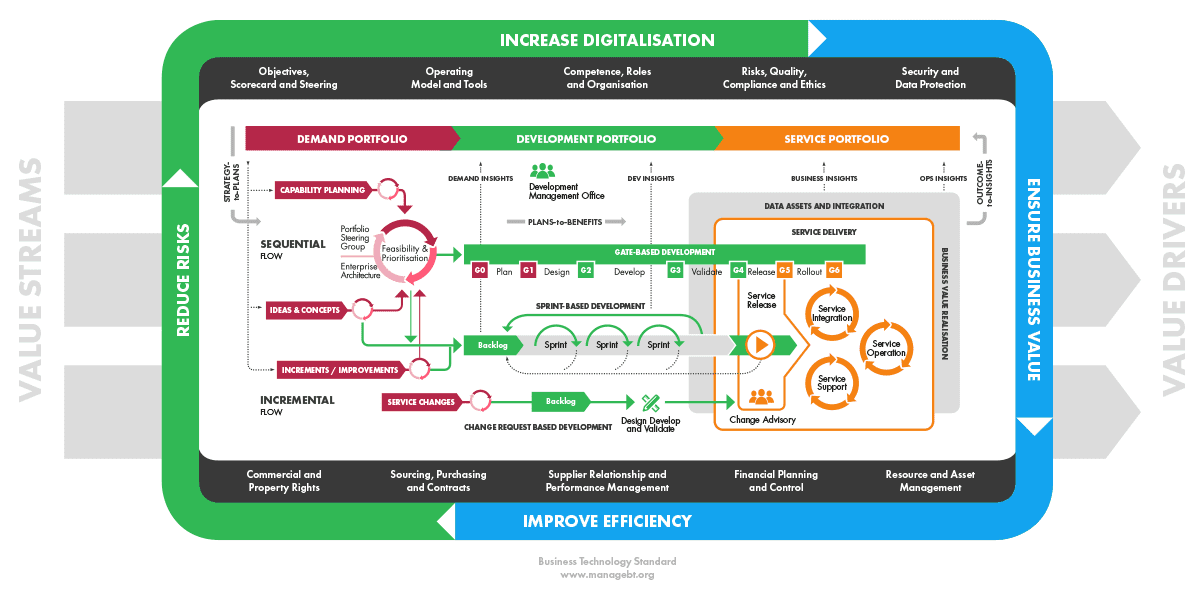The service operations ecosystem is in constant change. New and often quite small suppliers who have core competence in product and service development (although not necessarily in operating the services) are reshaping the ecosystem. The trend is to transfer traditional service operations from regional data centres into global data centres operated by new global mega players instead of traditional service providers. In general, the organisations are less dependent on dedicated operations management and have to deal with a more fragmented and complex operational ecosystem.
Service integration or Service Integration and Management (SIAM) today has a significant role as it defines how to manage services in a multi-vendor environment. It coordinates the whole service delivery ecosystem covering internal and external operations as well as local on-premise and global cloudified service operations.
Service integration and quality are responsible for:
Service integration promotes a collaborative culture in the ecosystem and directs focus from reactive issue resolution to proactive and preventive service management in good cooperation with all stakeholders.
Service integration and quality assurance is a multi-dimensional effort. Horizontal service integration represents the main service integration function as it goes across all services and major service providers. Horizontal service integration is often provided by internal resources together with, or even solely by, a service provider that does not have other major service responsibilities or interests in the ecosystem.
Vertical service integration is provided by the main service providers who have accountability for the service integration and quality within their service delivery scope. Vertical service integration must be compliant with processes, policies and guidelines provided by the horizontal service integration.
Figure 6.1.1 The dimensions of service integration
Service integration and quality require all delivery ecosystem parties to strictly follow the set guidelines and practices. Service integration requires standard operational procedures, defined roles and responsibilities, as well as processes and document templates to cover the typical use cases. Most procedures, such as incident and change management, can apply global best practices from ITIL, while others, like service compliance, require organisation-specific definitions.
The Business Technology Standard groups the standard operational procedures as follows:
Figure 6.1.2 Service integration topics and related processes and activities
Efficient execution of service integration requires tools to manage and automate the processes. Whether implemented simultaneously or gradually, it is recommended to set up tools for service management as the following:
The increasing business criticality and diversity of the services call for dedicated service integration capability. A service integration team, or in large companies, a service integration centre, is usually a good and effective way to ensure the execution of service integration across all services.
The service integration team/centre is responsible for:
The business technology service integration centre is responsible for horizontal service integration while service providers’ service integration centres are responsible for vertical service integration within the vendor’s responsibility area.
Figure 6.1.3 Service integration centre
The service integration team/centre is responsible for defining standard procedures and governing the proper implementation of services. It works mainly with service providers and runs a service integration steering group chaired by the Business Technology Operations Officer (BTOO).
The service desk is a single point of contact for service users and has the best visibility of the most up-to-date service status. Good collaboration and cooperation between the service integration team/centre and service desk will improve the capability to respond to and prevent service failures.
Change Advisory Board (CAB) is responsible for approving the service releases while the service integration team/centre is responsible for defining the operational readiness procedure and consulting services for building the readiness. Close cooperation will improve the service release quality and reduce the number of release-related service issues.
The service integration team/centre also reports and analyses the service performance and consults development and operations teams related to continual service improvement.
When working in close cooperation with other functions, the service integration team/centre can contribute to the following objectives:
Usually, in bigger organisations, a good-quality service integration can be achieved by forming a service integration centre with service integration leads for each standard procedure category and additional service integration centre experts for analysis, automation and maintenance activities. In smaller organisations, one person can have two roles and the service integration team can be staffed with fewer resources.
